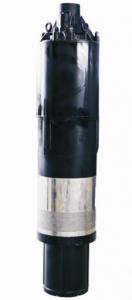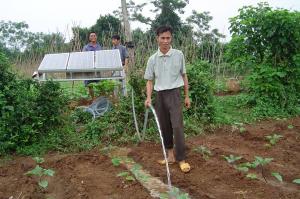Ebay Solar Pump 3ds-10-50
- Loading Port:
- China Main Port
- Payment Terms:
- TT OR LC
- Min Order Qty:
- -
- Supply Capability:
- 300 sets /month
OKorder Service Pledge
OKorder Financial Service
You Might Also Like
Product description:
Product: Solar water pump
Model:3DS-10
 Appilication:
Appilication:
submersible pump
for deep well or water tank or pond or small lake
for irrigation of a farm cover around 5000 m2
For all kinds of irrigation: flood /sprinkling/ drip
Product specification:
flow rate:8000 liter/ hour, 64m3/day.
lift: 10m-50m
pump diameter: 238mm
well diameter more than 250mm
with BLDC motor, motor power:2000W
but only need solar power:960W, our pump can save more than 50% solar panel power.
Material:
Pump inside: stainless steel and wearable nylon,it enables our solar pump to have 10 years sevice life.
Motor length:30cm,80% shorter than other motors. So that you can pump 80% more water by our solar pump.
Certification:
3 International patent
ISO9001
CE
Warranty:2 years
- Q: What is the maximum size of particles that a solar pump can handle?
- Depending on its specific model and design, the solar pump's capacity to handle particles of different sizes may vary. Generally, solar pumps are engineered to effectively manage particles that are small to medium in size. Such particles encompass dirt, sand, small pebbles, and various debris that may exist in the water source. The impeller or filtration system of the pump typically establishes the size limit. To ascertain the maximum particle size that a specific solar pump can accommodate, it is crucial to refer to the manufacturer's specifications or guidelines.
- Q: Can a solar pump be used in areas with limited access to water systems?
- Yes, a solar pump can be used in areas with limited access to water systems. Solar pumps are designed to operate using energy from the sun, making them ideal for remote or off-grid locations. They can be used to extract water from wells, rivers, or other natural water sources, providing a reliable and sustainable water supply in areas where traditional water systems are not available.
- Q: Are solar pumps suitable for use in cold climates?
- Yes, solar pumps are suitable for use in cold climates. They can continue to operate efficiently even in freezing temperatures, and with proper insulation and protection, they can withstand harsh winter conditions. Additionally, the use of solar energy ensures a sustainable and cost-effective solution for pumping water in cold climates.
- Q: How does the elevation affect the performance of a solar pump?
- Elevation plays a significant role in determining the performance of a solar pump. As the elevation increases, the performance of the solar pump decreases due to several factors. Firstly, at higher elevations, the air density decreases. This reduction in air density leads to a decrease in the efficiency of the solar panels as they receive less sunlight per unit area. As a result, the amount of electricity generated by the solar panels decreases, affecting the overall performance of the pump. Secondly, higher elevations usually entail longer pumping distances. As the pump has to work against gravity to lift water to higher altitudes, it requires more energy to overcome the increased head pressure. This additional energy requirement leads to a decrease in the pump's efficiency and performance. Furthermore, the pressure head at higher elevations is lower due to the decrease in atmospheric pressure. This lower pressure head affects the pump's ability to push water, resulting in reduced flow rates and decreased pumping capacity. Finally, at higher elevations, the ambient temperature tends to be lower. Solar panels function more efficiently at lower temperatures, so this can be an advantage. However, lower temperatures also affect the overall performance of the pump as it may lead to freezing of the water, which can damage the pump's components or hinder its operation. Overall, the elevation affects the performance of a solar pump by reducing the efficiency of solar panels, increasing the energy requirement to overcome the head pressure, decreasing the pressure head, and potentially causing freezing issues. Therefore, it is crucial to consider the elevation when designing and selecting a solar pump to ensure optimal performance and efficiency.
- Q: Can solar pumps be used for water supply in golf courses or sports facilities?
- Yes, solar pumps can be effectively used for water supply in golf courses or sports facilities. These pumps harness solar energy to power the pumping mechanism, making them a sustainable and cost-effective solution for water supply. They can efficiently meet the water demands of these facilities, ensuring adequate irrigation and maintenance of the playing surfaces. Additionally, solar pumps offer the advantage of being environmentally friendly by reducing reliance on fossil fuels and minimizing carbon emissions.
- Q: Are there any limitations to the depth of water a solar pump can lift?
- Yes, there are limitations to the depth of water a solar pump can lift. The maximum depth a solar pump can lift water depends on various factors such as the power output of the solar panels, the efficiency of the pump, and the capacity of the pump. Generally, solar pumps are most effective for lifting water from depths up to around 200 feet (60 meters). Beyond this depth, additional measures such as using multiple pumps in series or employing a different type of pump may be required.
- Q: How does a solar pump handle water source contamination from paper or pulp mills?
- A solar pump does not have the ability to directly handle water source contamination from paper or pulp mills. However, it can be used to pump water from contaminated sources to a treatment facility where appropriate measures can be taken to remove or neutralize contaminants.
- Q: How do I ensure the compatibility of a solar pump with my existing water infrastructure?
- To ensure the compatibility of a solar pump with your existing water infrastructure, there are a few key steps you can follow. 1. Assess your water infrastructure: Begin by evaluating your current water infrastructure, including the type and size of pipes, the depth of your well or water source, and the flow rate and pressure requirements of your existing system. This information will help determine the compatibility of a solar pump. 2. Determine power requirements: Solar pumps come in various sizes and power ratings. Calculate the power requirements based on the depth of your water source, desired flow rate, and any additional factors like lifting height or distance. Ensure that the solar pump you choose can meet these power requirements. 3. Consider pump specifications: Look for a solar pump that matches the specifications of your existing system, such as the pipe diameter, pressure ratings, and flow rate compatibility. This will ensure seamless integration with your water infrastructure. 4. Consult with experts: Seek advice from solar pump manufacturers, suppliers, or professionals who have experience in solar water pumping systems. They can guide you through the selection process, provide expert recommendations, and help ensure the compatibility of the solar pump with your existing infrastructure. By following these steps and getting expert assistance, you can ensure the compatibility of a solar pump with your existing water infrastructure, maximizing its efficiency and effectiveness.
- Q: Can solar pumps be used in remote locations?
- Yes, solar pumps can be used in remote locations. They are especially suitable for remote areas where electricity supply is limited or unreliable. Solar pumps operate solely on solar energy, eliminating the need for grid electricity or fuel, making them a cost-effective and sustainable solution for remote locations.
- Q: How does a solar pump handle water with high levels of nitrates or other contaminants?
- A solar pump alone does not handle water with high levels of nitrates or other contaminants. It is primarily responsible for pumping water from a source, such as a well or a body of water, using solar energy. However, additional filtration or treatment systems are required to handle water with high levels of nitrates or contaminants. These systems can include activated carbon filters, reverse osmosis, or other appropriate treatment methods to ensure the water is safe and suitable for use.
Send your message to us
Ebay Solar Pump 3ds-10-50
- Loading Port:
- China Main Port
- Payment Terms:
- TT OR LC
- Min Order Qty:
- -
- Supply Capability:
- 300 sets /month
OKorder Service Pledge
OKorder Financial Service
Similar products
Hot products
Hot Searches
Related keywords





















